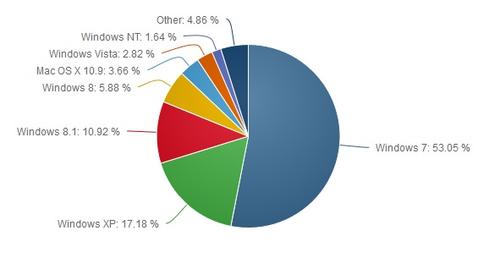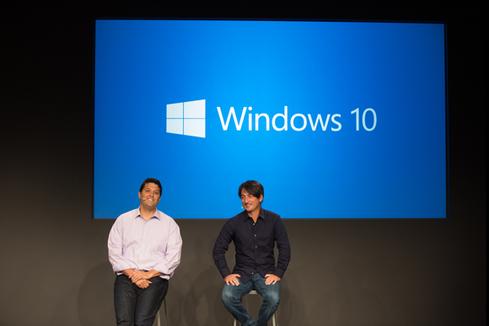Windows 8.1: On The Rise?
Windows 8.1 achieves big market-share gains in October, just as Windows XP starts to plummet. But is Win 8.1's momentum sustainable?


Windows 10: 11 Big Changes
Windows 10: 11 Big Changes (Click image for larger view and slideshow.)
How's this for some Halloween witchcraft? After months of being shunned by buyers, according to web-tracking firm Net Applications, last month Windows 8.1 somehow conjured its largest market-share gains to date, snaring more ground in four weeks than it had during the rest of the year combined.
Back-to-school sales and other short-term factors played an obvious role in the uptick, so it remains to be seen whether Microsoft's October progress was merely a blip or the start of a sustained upward trend. Still, the news continues a good month for some of Microsoft's historically troubled products. After losing over $1 billion to date, the Surface line finally flirted with profitability last quarter, propelled by the well-received Surface Pro 3.
Windows 8 and 8.1 combined for 16.8% of active PC users, a metric Net Applications derives by monitoring web traffic to the hundreds of thousands of sites in its network. That's up massively from 12.26% in September and only 9.25% in October 2013.
Despite the progress, Microsoft's newest OSs are still far, far behind the market leader, Windows 7. The OS most chosen by businesses that upgraded this year from Windows XP, Win 7 claimed a little over 53% of users, a slight increase relative to last month. Windows 7 held 46.42% of the market in October of last year.
[Despite its popularity, are we seeing the beginning of the end for Windows 7? Read Windows 7's Halloween Deadline: 5 Key Issues.]
Through September, Windows 7 had generally gained more market share over rolling-year comparisons than had Windows 8 and 8.1. Thanks to Windows 8.1's October surge, that's no longer true. Over the last year, Windows 8 and 8.1 have gained a market-leading 7.55 percentage points of market share, compared to 6.63 percentage points for Windows 7.
Windows 8 and 8.1 also trailed Windows XP, though not by much. Microsoft stopped supporting the aging OS earlier this year, but as of September almost a quarter of PC users were still using it. Last month the floor finally fell out, with Windows XP share dropping to 17.18%. That's down all the way from 31.24% at the same point in 2013.
Apple's most popular OS continued to be OS X 10.9, more commonly known as Mavericks. Its share dropped from 4.05% to 3.66% as some Mac users began migrating to OS X Yosemite, released last month. Last quarter, Apple posted its best-ever Mac sales, an impressive feat given that the overall PC market remains somewhat depressed. Nevertheless, Windows continues to lead the PC OS race. Over 91% of PC users ran some version of Windows in October, compared to around 7% who ran some variant of OS X.
Statistics like those that Net Applications produces are intrinsically prone to sampling limitations and other error-inducing variables, so all of the aforementioned figures should be considered approximate. The most recent Net Applications data also includes some unusual findings, such as a strangely large jump in the "Other OS" category, which might indicate October's sample was somehow irregular. But other web tracking services have observed trends that broadly align with Net Applications' findings. StatCounter (which, like Net Applications, tracks user activity rather than individual users) also found that Windows 8 and 8.1 have risen while XP has fallen off. Relative to the Net Applications numbers, StatCounter's figures indicate these trends are unfolding more slowly, however. StatCounter also assigns a much greater share to OS X, which suggests Mac owners use their computers more than many PC users do.
However much credence one gives to one set of market-share data or another, it's evident that Windows 8.1 sales have accelerated in recent months. Given the OS's ignominious sales history, that's a good thing for Microsoft -- but as mentioned, the upswing might trail off quickly.
Windows 8.1's breakout was in some ways inevitable. On October 31, Microsoft closed down sales of both most Windows 7 PC and retail licenses of Windows 8, meaning that for consumers, Microsoft will be pushing only Windows 8.1 devices until Windows 10 hits the market next year. But even before the Halloween deadline, retailers had replaced old inventory with newer models -- such as the fleet of budget-friendly Windows 8.1 devices released over the late summer and fall.
Some users with dying XP machines might simply buy iPads as replacements, but most people still require traditional PCs at least some of the time. When these people show up at the store or browse online, they find Windows 8.1 models more easily than they'll find Win 8 or Win 7 ones. Unless all PC shoppers switch to Macs or go Linux, Microsoft should continue to accrue this sort of inevitable momentum until Windows 10 arrives. Windows 10 itself has been relatively well received, which might drive a sustained, if difficult-to-pinpoint, increase in Windows 8.1 drives.
But general PC demand was only one aspect in Windows 8.1's strong October. As mentioned, back-to-school sales were surely a factor as well. It's also likely many Windows XP users finally got around to upgrading. Both of these are relatively short-term stimulants that won't necessarily help Windows 8.1 to maintain momentum. It's quite possible Windows 8.1 will continue to make gains throughout the holidays, for example, but with new iPads and the Nexus 9 on the market, will Win 8.1's progress start to drop off?
Let us know what you think in the comments.
If the world weren't changing, we might continue to view IT purely as a service organization, and ITSM might be the most important focus for IT leaders. But it's not, it isn't, and it won't be -- at least not in its present form. Get the Research: Beyond IT Service Management report today. (Free registration required.)
About the Author(s)
You May Also Like







